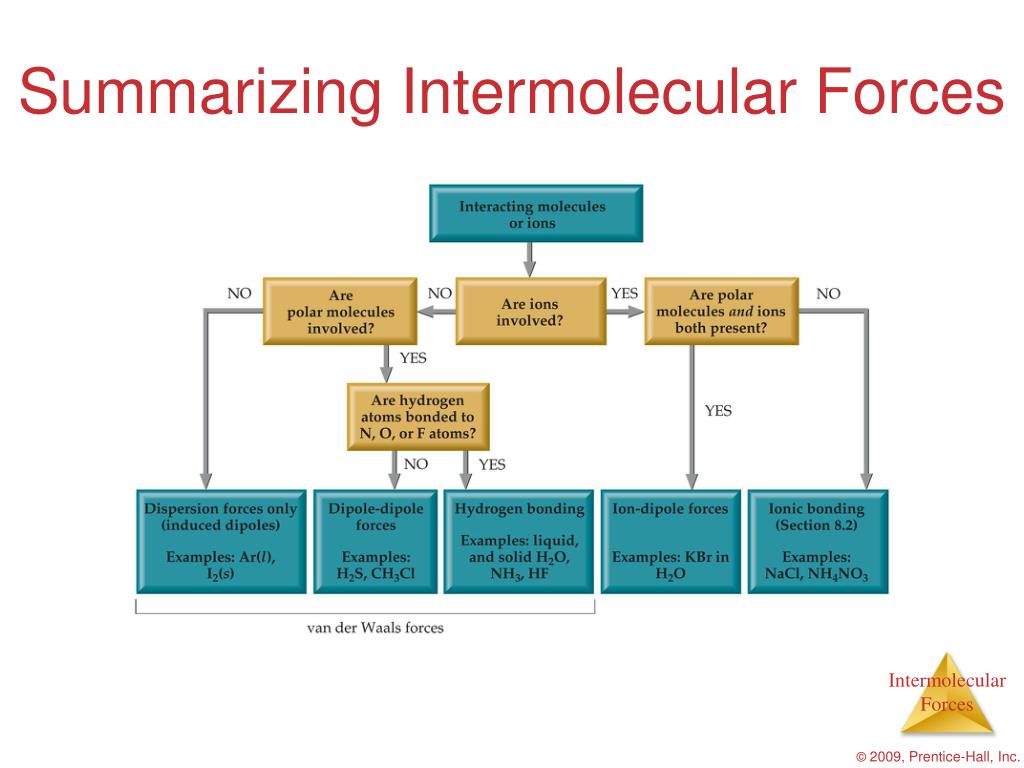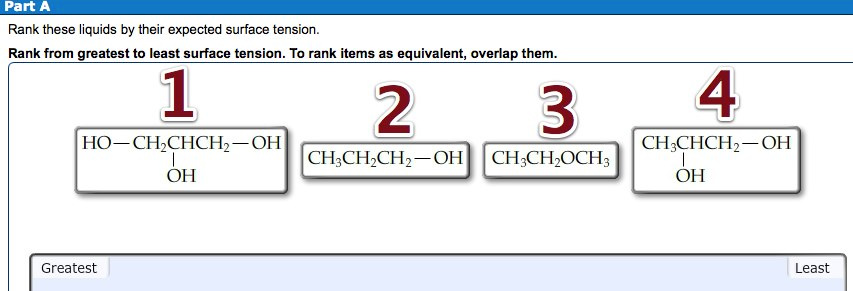44 surface tension intermolecular forces
Surface Tension & Capillarity with Application, Formula & Examples The surface tension is the force acting perpendicular on a unit length of an imaginary line drawn on the surface of the liquid and it can be expressed as T=F\l Here, T is surface tension, F is the force acting on the surface (Cohesive force) and l is unit length Because of surface tension, few insects can easily float on the liquid surface. How do intermolecular forces affect surface tension? | Socratic Intermolecular forces are forces that hold molecules together. They attract each other (either in dipole-dipole or London forces) and hold each other together. This explains why solutions with higher intermolecular forces have a lower vapor pressure, higher boiling point, and is generally more viscous.
Surface Tension of Intermolecular Forces - QS Study So a force of attraction exists When the intermolecular distance is less, there is overlapping of the electron clouds of the molecules resulting in a strong repulsive force. The intermolecular forces are of two types. They are: (i) cohesive force and (ii) adhesive force.
Surface tension intermolecular forces
Surface Tension - Purdue University Surface tension is measured as the energy required to increase the surface area of a liquid by a unit of area. The surface tension of a liquid results from an imbalance of intermolecular attractive forces, the cohesive forces between molecules: A molecule in the bulk liquid experiences cohesive forces with other molecules in all directions. How do intermolecular forces affect surface tension? - Answers The surface tension is a function of cohesive forces generated by intermolecular forces among similar molecules. Very rightly since both the parameters are dynamic in natures and hence a 3rd... Surface Tension | List of Factors Affecting It | Chemistry Grade XI Chemistry Grade 11 Notes: Surface Tension. Factors affecting surface tension: Intermolecular force of attraction, Temperature, Presence of impurities. Cohesive and Adhesive Force. Surface tension can be defined as the tangential force per unit length acting perpendicularly to the line drawn in the surface of the liquid.
Surface tension intermolecular forces. 11.4: Intermolecular Forces in Action- Surface Tension, Viscosity, and ... surface tension is the energy required to increase the surface area of a liquid by a unit amount and varies greatly from liquid to liquid based on the nature of the intermolecular forces, e.g., water with hydrogen bonds has a surface tension of 7.29 x 10 -2 j/m 2 (at 20°c), while mercury with metallic bonds has as surface tension that is 15 times … INTERMOLECULAR FORCES-SURFACE TENSION - YouTube A discussion and demonstration of intermolecular forces, with examples of surface tension. Surface Tension - University of Florida Surface tension is caused by the effects of intermolecular forces at the interface. Surface tension depends on the nature of the liquid, the surrounding environment and temperature. Liquids were molecules have large attractive intermolecular forces will have a large surface tension. See a diagram: Forces within the body of a liquid The calculation of surface tension from intermolecular forces ... Fetching data from CrossRef. This may take some time to load.
Surface tension - University of Tennessee Wetting is the ability of liquids to form interfaces with solid surfaces. The contact angle θ between the liquid and the solid surface is a measure of the degree of wetting. A smaller the contact angle and a smaller the surface tension result in a greater the degree of wetting. When adhesive forces are greater than cohesive forces, the contact angle θ lies between 0 and 90 o. Surface tension: Intermolecular, Cohesive, Adhesive force Surface tension Intermolecular forces The force between two molecules of a substance is called intermolecular force. This intermolecular force is basically electric in nature. Intermolecular Forces and Surface Tension (Nancy Sexton) Intermolecular Forces and Surface Tension (Nancy Sexton) 2.a Students know atoms combine to form molecules by sharing electrons to form covalent or metallic bonds or by exchanging electrons to form ionic bonds. 2.d Students know the atoms and molecules in liquids move in a random pattern relative to one another because the intermolecular forces ... Surface tension | States of matter and intermolecular forces ... Surface tension in water, and how the surface tension is related to hydrogen bonding.Watch the next lesson: ...
intermolecular-forces-and-surface-tension-Cort.docx There are six types of intermolecular forces. The type of intermolecular forces is dependent on the type of molecules interacting. Intermolecular forces are the primary reason behind the properties of liquids such as surface tension, viscosity, vapor pressure, boiling point, and heat of vaporization. How is the surface tension related to the intermolecular forces? surface tension and viscosity are unique properties of liquids that depend on the nature of intermolecular interactions. The stronger the intermolecular interactions, the greater the surface tension. Liquids that have strong intermolecular forces tend to have high viscosities. Surface Tension: Intermolecular forces - BrainKart Surface Tension: Intermolecular forces The force between the like molecules which holds the liquid together is called 'cohesive force'. When the liquid is in contact with a solid, the molecules of the these solid and liquid will experience an attractive force which is called 'adhesive force'. SURFACE TENSION Intermolecular forces How do intermolecular forces affect surface tension? | Socratic The intermolecular forces present in a sample of water are hydrogen bonds . The high surface tension of water allows a paper clip to "float" on the surface of the water. It's not actually floating, it's resting on top of the hydrogen bonds that exist between the water molecules at the surface.
Surface Tension and Intermolecular Forces - Ashana S Nira U... The better the intermolecular force, the stronger the surface tension. Water for example has the intermolecular force of hydrogen bonding which is the strongest one resulting in a very strong surface tension. Oil on the other hand have Vanderwaals forces between the molecules which is a lot more weaker resulting in lower surface tension.
What Is Surface Tension? Definition and Experiments Causes of Surface Tension . Various intermolecular forces, such as Van der Waals forces, draw the liquid particles together. Along the surface, the particles are pulled toward the rest of the liquid, as shown in the picture to the right. ... The total force from the surface tension (from both the inner and outer film) is, therefore, 2gamma (2pi R).
How does surface tension depend on intermolecular forces? - Answers Of course, viscosity is resistance of flow and surface tension of lateral force but viscosity is s display of frictional force during laminar flow caused due to intermolecular forces. The surface ...
Measuring Surface Tension to Investigate Intermolecular Forces This provides a simple opportunity for students to get used to some of the logistics such as choosing a liquid, using the ruler appropriately, and determining the point in the video they will measure the stretch of the liquid. Additionally, since octane has a higher surface tension, they soon discover the macroscopic effects of having different sur...
How do intermolecular forces affect surface tension? by Irash Gomez - Prezi The intermolecular forces present in a sample of water are hydrogen bonds, Van Der Waals, and dipole-dipole. The high surface tension of these 3 solutions allows a paper clip to "float" on the surface of the water. It's not actually floating, it's resting on top of the hydrogen bonds that exist between the water molecules at the surface ...
How do intermolecular forces affect surface tension? 1) First of all, we will discuss the terms of surface tension and intermolecular forces. The surface tension is the term where it is a property of a liquid material that allows the liquid to resist the external force. The intermolecular forces give the idea about the strongness of a bond that is present between two molecules of a material.
How does surface tension relate to intermolecular forces? May 08, 2020 · Surface tension is the energy required to increase the surface area of a liquid by a given amount. The stronger the intermolecular interactions, the greater the surface tension. Liquids that have strong intermolecular forces tend to have high viscosities.





0 Response to "44 surface tension intermolecular forces"
Post a Comment